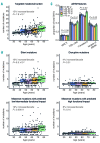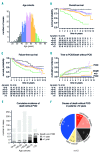Impact of age on genetics and treatment efficacy in follicular lymphoma
- PMID: 29545350
- PMCID: PMC6068024
- DOI: 10.3324/haematol.2018.187773
Impact of age on genetics and treatment efficacy in follicular lymphoma
Figures


Similar articles
-
Association of VEGFA-2578 C>A polymorphism with clinicopathological aspects and outcome in follicular lymphoma patients.Blood Cancer J. 2016 Aug 26;6(8):e464. doi: 10.1038/bcj.2016.76. Blood Cancer J. 2016. PMID: 27564462 Free PMC article. No abstract available.
-
Survival in elderly follicular lymphoma patients who receive frontline chemo-immunotherapy.Am J Hematol. 2010 Dec;85(12):963-7. doi: 10.1002/ajh.21878. Am J Hematol. 2010. PMID: 20981680 No abstract available.
-
Counterpoint: Can Chemotherapy Be Eliminated in the Treatment of Follicular Lymphoma?Oncology (Williston Park). 2018 Aug 15;32(8):404, 407-9. Oncology (Williston Park). 2018. PMID: 30153320 No abstract available.
-
[A case of follicular lymphoma of the duodenum treated with the combined therapy of anti-CD20 antibody and chemotherapy].Nihon Shokakibyo Gakkai Zasshi. 2006 Mar;103(3):301-9. Nihon Shokakibyo Gakkai Zasshi. 2006. PMID: 16688961 Review. Japanese. No abstract available.
-
[Advances in management of follicular lymphoma].Rinsho Ketsueki. 2014 Oct;55(10):1937-40. Rinsho Ketsueki. 2014. PMID: 25297758 Review. Japanese. No abstract available.
Cited by
-
[Chinese expert consensus on the diagnosis and management of elderly patients with follicular lymphoma (2024)].Zhonghua Xue Ye Xue Za Zhi. 2024 Sep 14;45(9):801-808. doi: 10.3760/cma.j.cn121090-20240701-00243. Zhonghua Xue Ye Xue Za Zhi. 2024. PMID: 39414601 Free PMC article. Chinese.
-
Evaluating upfront high-dose consolidation after R-CHOP for follicular lymphoma by clinical and genetic risk models.Blood Adv. 2020 Sep 22;4(18):4451-4462. doi: 10.1182/bloodadvances.2020002546. Blood Adv. 2020. PMID: 32941649 Free PMC article. Clinical Trial.
-
Cause of Death in Follicular Lymphoma in the First Decade of the Rituximab Era: A Pooled Analysis of French and US Cohorts.J Clin Oncol. 2019 Jan 10;37(2):144-152. doi: 10.1200/JCO.18.00400. Epub 2018 Nov 27. J Clin Oncol. 2019. PMID: 30481079 Free PMC article.
-
Impact of age on clinical risk scores in follicular lymphoma.Blood Adv. 2019 Apr 9;3(7):1033-1038. doi: 10.1182/bloodadvances.2019032136. Blood Adv. 2019. PMID: 30940638 Free PMC article.
-
[The clinical features, survival analysis, and geriatric assessment of 85 patients with follicular lymphoma: a single-center study].Zhonghua Xue Ye Xue Za Zhi. 2024 Mar 14;45(3):233-241. doi: 10.3760/cma.j.cn121090-20230815-00067. Zhonghua Xue Ye Xue Za Zhi. 2024. PMID: 38716594 Free PMC article. Chinese.
References
-
- Solal-Celigny P, Roy P, Colombat P, et al. Follicular lymphoma international prognostic index. Blood. 2004;104(5):1258–1265. - PubMed
-
- Federico M, Bellei M, Marcheselli L, et al. Follicular lymphoma international prognostic index 2: a new prognostic index for follicular lymphoma developed by the international follicular lymphoma prognostic factor project. J Clin Oncol. 2009;27(27):4555–4562. - PubMed
-
- Pastore A, Jurinovic V, Kridel R, et al. Integration of gene mutations in risk prognostication for patients receiving first-line immunochemotherapy for follicular lymphoma: a retrospective analysis of a prospective clinical trial and validation in a population-based registry. Lancet Oncol. 2015;16(9):1111–1122. - PubMed
-
- Weigert O, Weinstock DM. The evolving contribution of hematopoietic progenitor cells to lymphomagenesis. Blood. 2012;120(13):2553–2561. - PubMed
Publication types
MeSH terms
Substances
Grants and funding
LinkOut - more resources
Full Text Sources
Other Literature Sources

